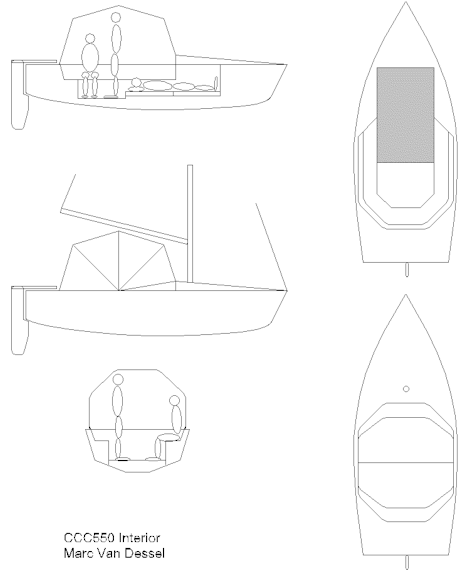|
CCC550
A fast and comfortable camp cruiser.
Marc Van Dessel marc.vandessel@siemens.atea.be
Specifications
| Length overall |
5.50 m |
| Length waterline |
5.20 m |
| Length Trailering |
6.85 m |
| Beam |
2.20 m |
| Draught boards up |
0.25 m |
| Draught boards down |
1.00 m |
| Interior headroom |
1.80 - 1.95 m |
| Displacement empty |
400 kg |
| Ballast |
200 kg |
| Trailering weight |
400 + 100 kg |
| Sail area |
9 + 6 m2 |
| Mast height above WL |
7.8 m |
| Sleeps |
2 |
| Sails |
4 |
| Building complexity |
small |
| Performance |
good |
| Luxury |
low |
Description
This design tries to combine the best sides of an
open boat and a yacht.
Exterior.
- When sailing, she is a real open boat. Nothing special in the
forms itself. A double chine. A wide and flat end should promote planing.
- The forward deck is rounded a bit to give more height inside.
- The cockpit is U-shaped with good backsides. In the middle is a
support that receives the mainsheet.
- The boat has two boards that swing up to allow beaching. They
also are safer than a daggerboard if something is hit under the water.
- Using two boards also has the advantage of leaving the cockpit
floor flat.
- When not sailing, the foldable tent can be unfolded. The material
for the tent is the same as used for dodgers: aluminum supports and a fabric of Sunbrella
or similar.
Interior
- The forward part of the interior forms a real sized berth: 1.20m
x 2.00 m. The mattress is in three pieces and can be stowed under the fore deck. The
pieces can be strapped to the ceiling to keep clear from water on the cockpit floor. The
forward part of the cockpit floor is raised 5 cm and the after part has a self-draining
pipe.
- Room for stowage is available at both sides of the berth and
under the cockpit seats.
- Under the folding tent is enough headroom to make overnighting a
pleasure: nearly everywhere more then 1.80 m.
- The aft side of the tent can be opened. This ‘door’ has
a window in it.
- The cockpit now doubles as interior seats. A table can be mounted
on the support in the middle.
Stability
- Ballast is used for stability. It is split in three parts.
- 150 kg under the cockpit floor. Steel plate is used because
it’s cheaper and it adds to the strength of the boat.
- Each of the boards has 25 kg down low in the tip. Here it’s
better to use lead because it’s much denser.
- The behavior of the boat is in between a dinghy and a yacht. It
has enough stability and momentum to allow the crew to shift their weight or to release
sail.
- The boat is to be sailed upright because of the hull form.
However when speed isn’t that important, don’t care too much.
Sail
- A conventional rig is used. No genoa but a jib. This makes
tacking much easier, and doesn’t need a winch.
- Eventually, a second hand mast and sails can be used (470 or
similar)
Motor
- A small outboard is sufficient. Because the boat sails so well,
the motor will only be used for docking and in extreme wind conditions (no wind or too
much wind).
Trailer
- A standard boat trailer can be used.
Building technique
- Stitch and glue is the best way to produce a strong and light
boat in a minimum time.
- 6 and 8 mm ply is used. Every exposed surface is to be covered
with glass and epoxy.
Time to build
Cost
- 5000$ including motor and trailer
Pro's
- cheaper than a real cruiser
- manageable size
- easy to build
- light : easy to trailer, easy to launch, easy to handle, fast
- good performance; possibility of planing; high level of fun
- good stability; low center of gravity due to ballast in boards
- double boards : free cockpit (flat bottom); easier to handle 2 x
25 kg than 1 x 50 kg
- double use of cockpit; a lot of interior space in a small boat
- full size berth
- full standing headroom
- lots of storage space
- comfortable and appealing cockpit
- self draining cockpit with raised forward part
- self righting
Con’s
- less protection in high seas, strong winds
- interior is exposed during sail
- cockpit takes a lot of water during capsize (but is self
draining)
- very basic accommodation (cooking, toilet)
|
Drawings



|